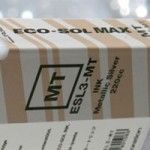
Recientemente realizamos una encuesta a nuestros usuarios que operan dispositivos de nuestra línea capaces de imprimir en metálico, y encontramos algunos datos interesantes que nos gustaría compartir. La encuesta fue enviada a más de 500 usuarios y fue respondida por un 29% de éstos, lo cual fue suficiente para que sea estadísticamente significativa. Para comenzar, el 61% de los usuarios que respondieron tienen dispositivos configurados para funcionar con las tintas metálicas Eco Sol Max de Roland DG.
El 61% de dichas unidades está configurado para funcionar con la tinta metálica.
Las etiquetas y calcomanías encabezaron la lista de aplicaciones, lo cual era de esperarse por dos motivos: primero, toman ventaja de las habilidades de impresión y corte de nuestros dispositivos, los cuales nuestros usuarios las conocen mejor que nadie. Segundo, las calcomanías son generalmente más pequeñas y se tienen que ver de cerca, y es allí donde en verdad se puede apreciar el efecto metálico. También encuentro interesante ver que en la lista también están impresiones fotográficas y sobre lienzo, lo cual me indica que nuestros usuarios se aventuran en algunas aplicaciones rentables, versus aplicaciones tradicionales de letreros y serigrafía.
Principales aplicaciones para la tinta metálica.
Lo verdaderamente asombroso fue que el 81% de estos clientes cobra más por estos trabajos (¿o es asombroso que el 16% no lo haga?) ¡Casi el 50% de ellos cobra una prima de 21% o más por cada impresión! ¿Puede usted cobrar más? ¡El 81% lo hace!
¿Puede usted cobrar más? El 81% lo hace.
¿Necesita más pruebas de que nuestra galardonada tinta metálica (producto del año 2009) es una fuente de dinero? Aquí una publicación de Signs101 (membresía requerida). Me agrada que este usuario mencione dos temas clave: el precio y la manipulación del flujo de trabajo. Por ejemplo, la velocidad de impresión no era un problema ya que él configura sus trabajos de impresión metálica durante la noche.
Si le interesa saber más, tenemos muchos más recursos en nuestro sitio Web:
- Un video inspirador sobre la tinta metálica.
- Un video instructivo sobre la tinta metálica: Creación de Gráficos con Tinta Metálica usando Adobe Illustrator®.
- Los próximos seminarios en línea de Roland DGA Academy sobre impresión con tinta metálica, usando una variedad de paquetes de software.
- La página Web de soluciones con tinta metálica tiene mucha información sobre todo lo relacionado con la impresión con esta tinta de Roland DG.
- Actualizado: vínculo a un flujo de trabajo con tinta metálica usando Corel X5.
Si usted no está considerando la impresión con tinta metálica para incrementar su rentabilidad (y su diferenciación), pues debería. Pero no soy imparcial: a todo siempre le veo un lado positivo.
Gracias por leerme,
Rick




